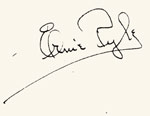Skip to comments.
BUDAPEST IS TAKEN AT COST OF 159,000 TO FOE; BRITISH CLEAR REICHSWALD, PATTON PUSHES ON (2/14/45)
Microfilm-New York Times archives, Monterey Public Library
| 2/14/45
| C.L. Sulzberger, Clifton Daniel, Gene Currivan, Richard J.H. Johnston, Russell Porter, more
Posted on 02/14/2015 4:14:17 AM PST by Homer_J_Simpson
1
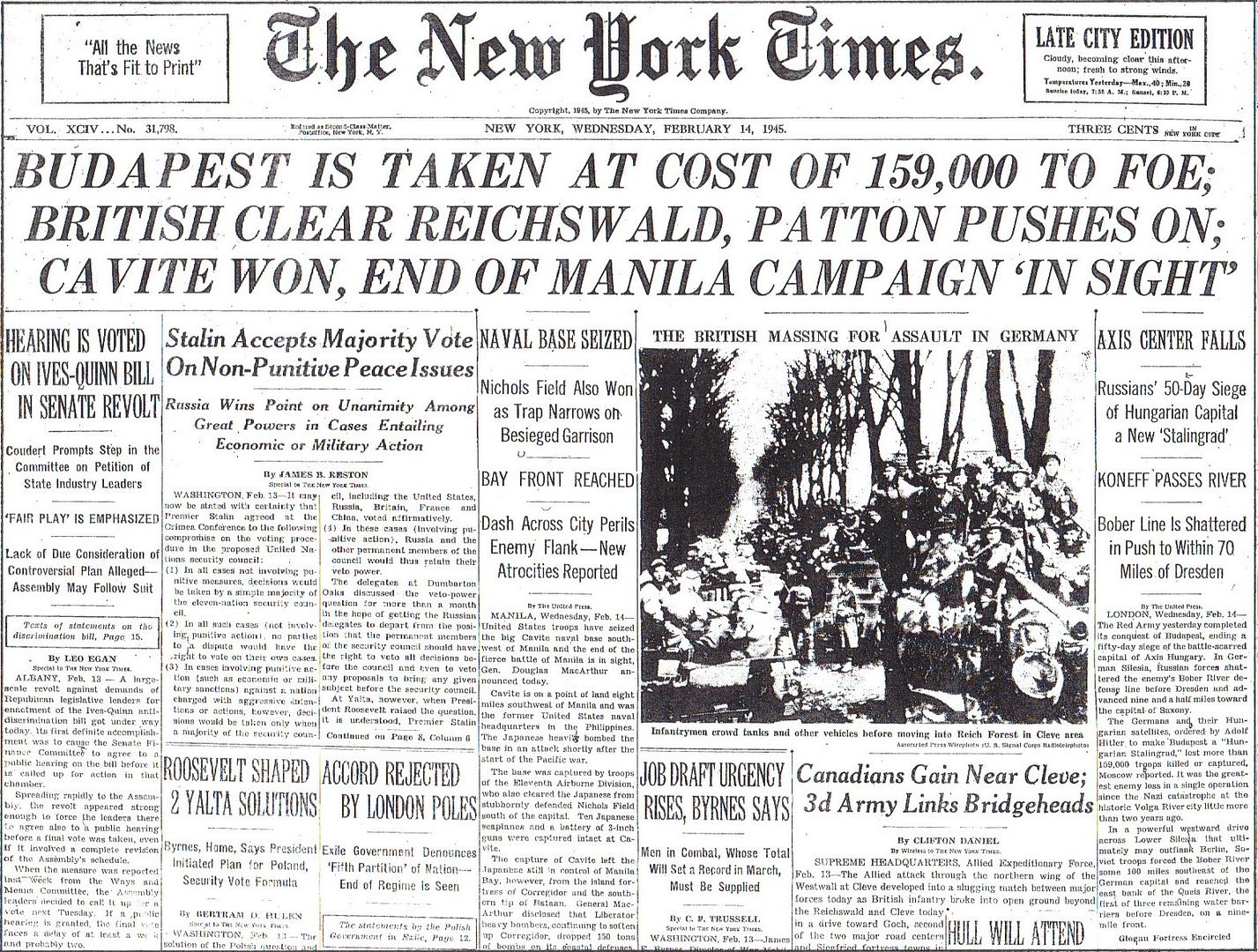
2
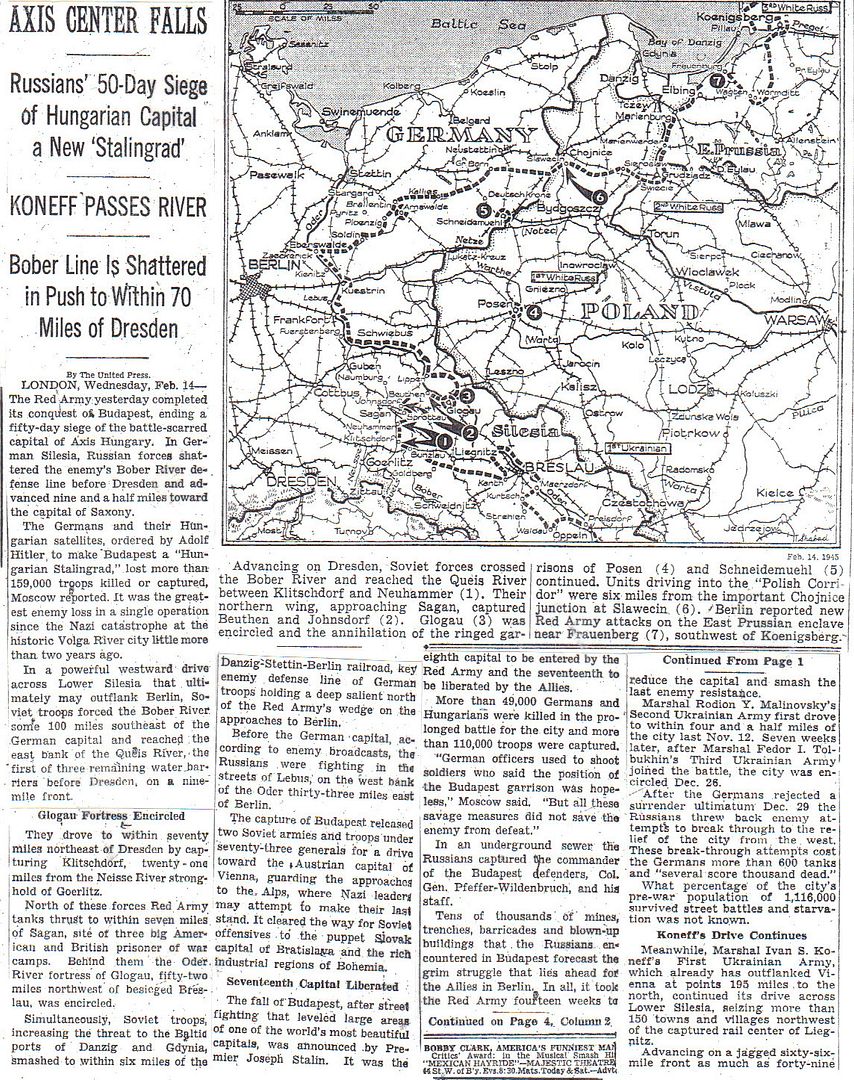
3
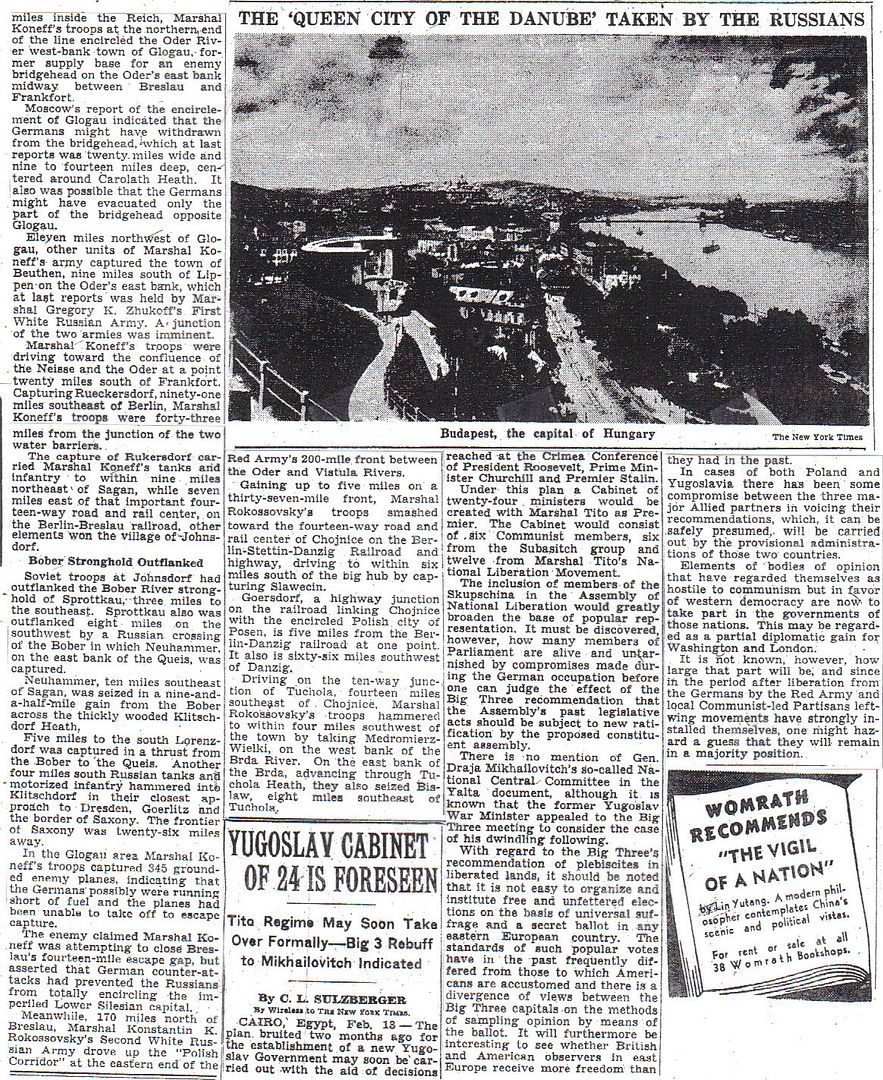
4
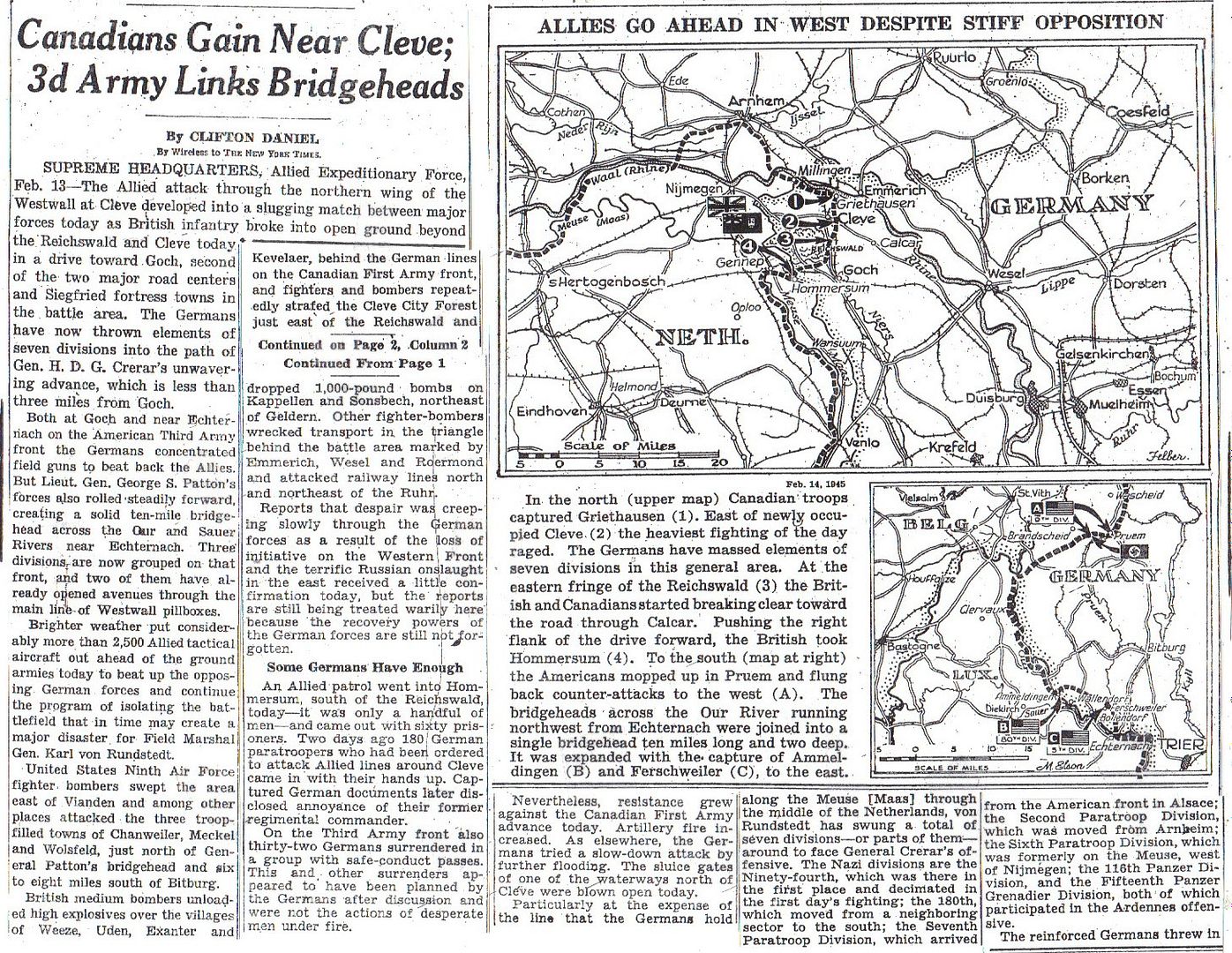
5
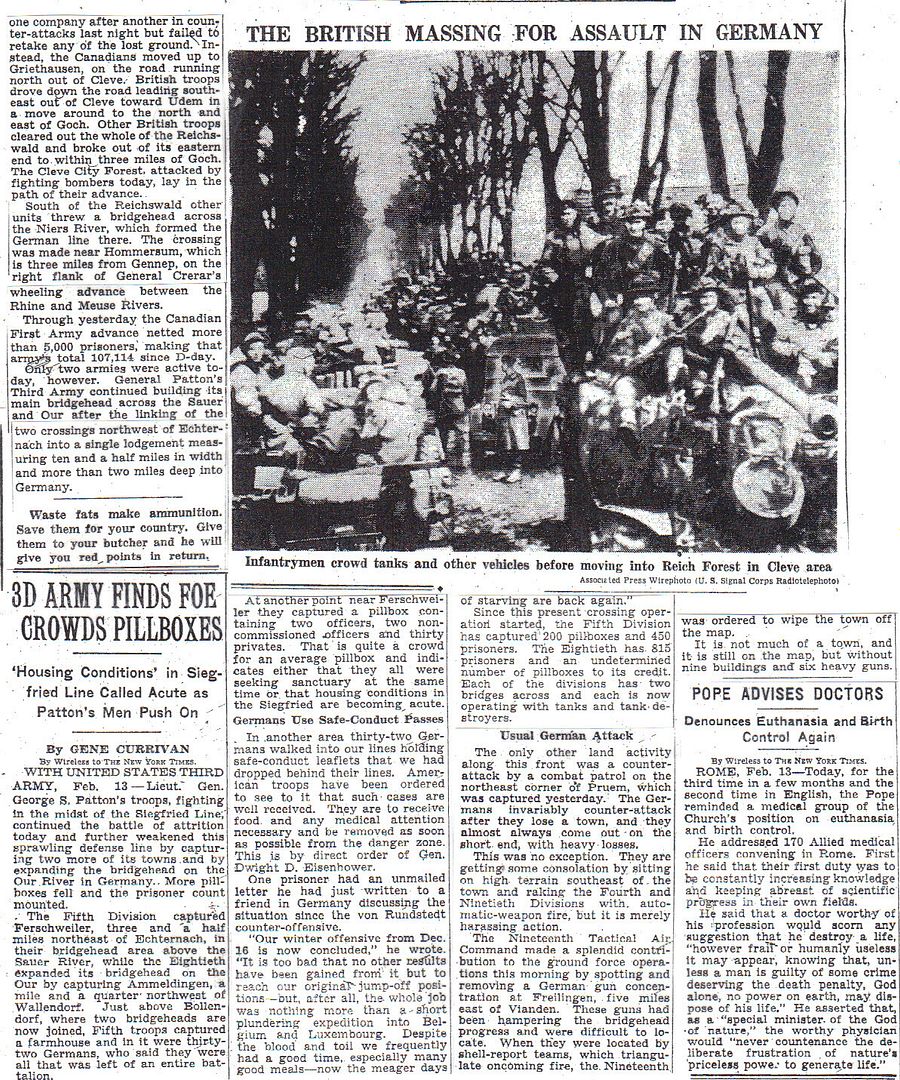
6
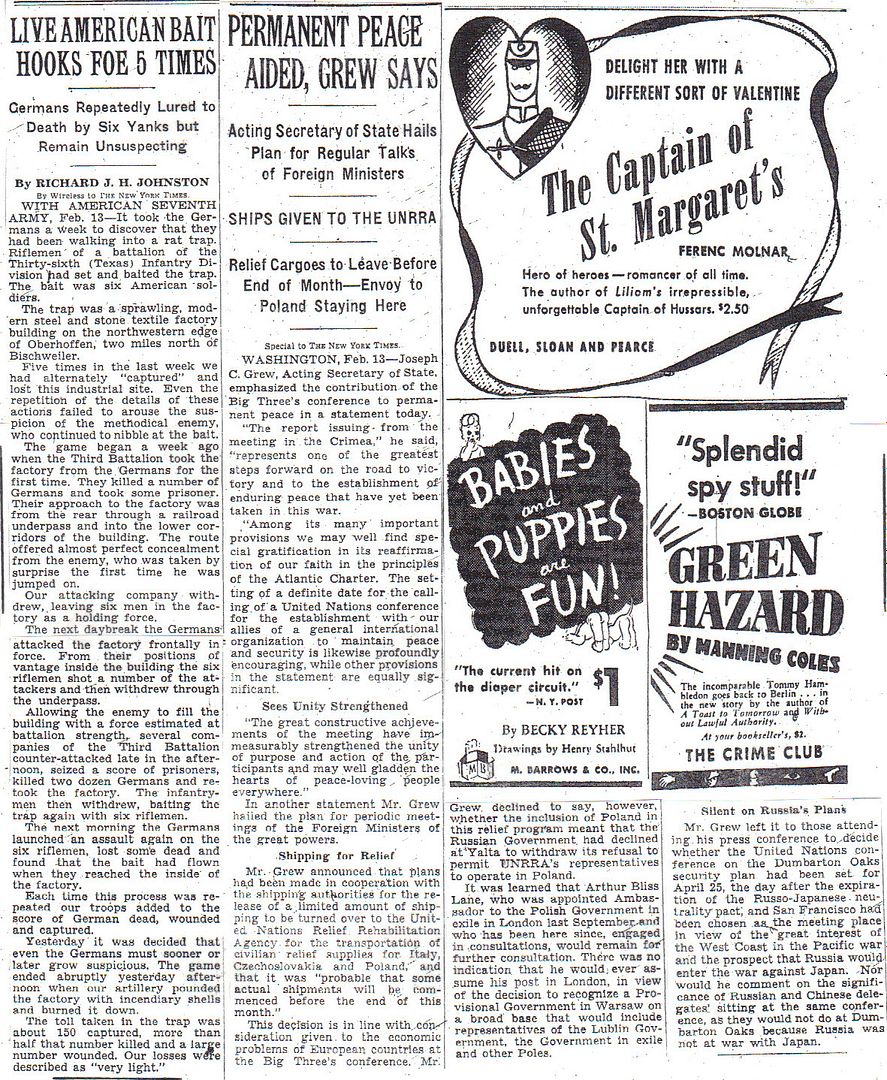
7
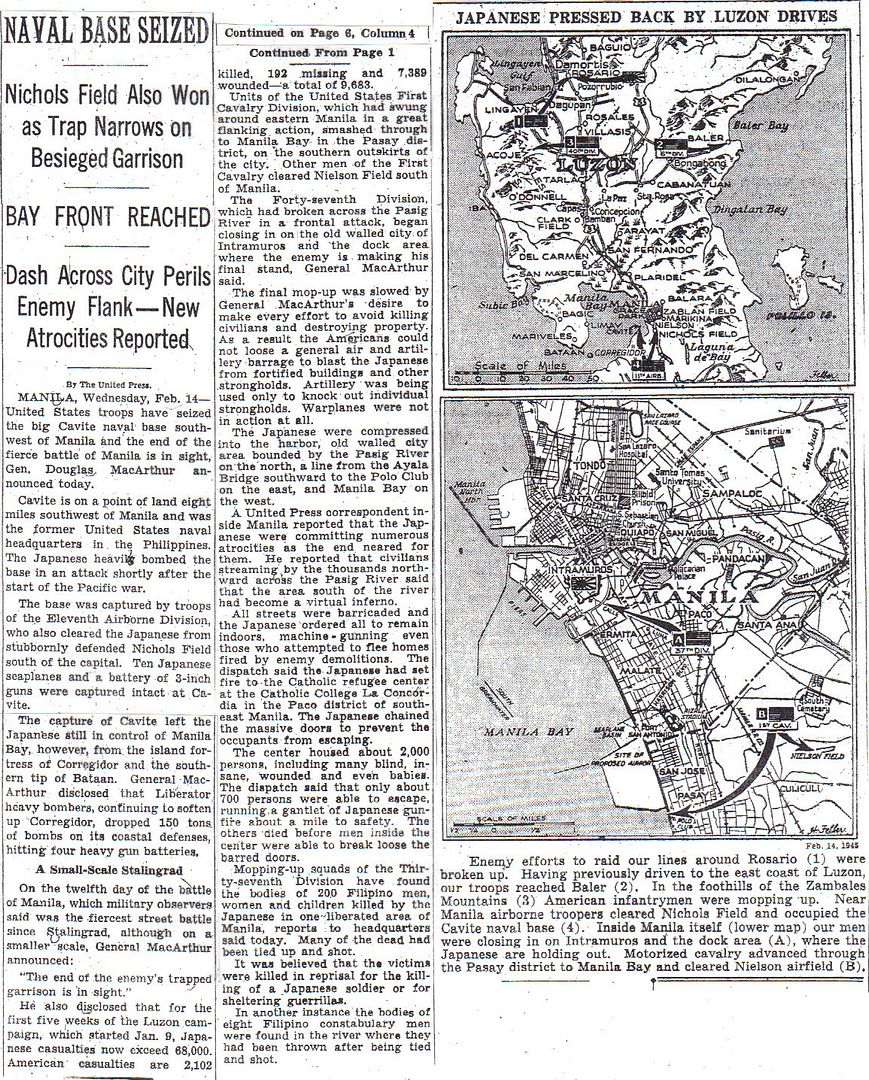
8
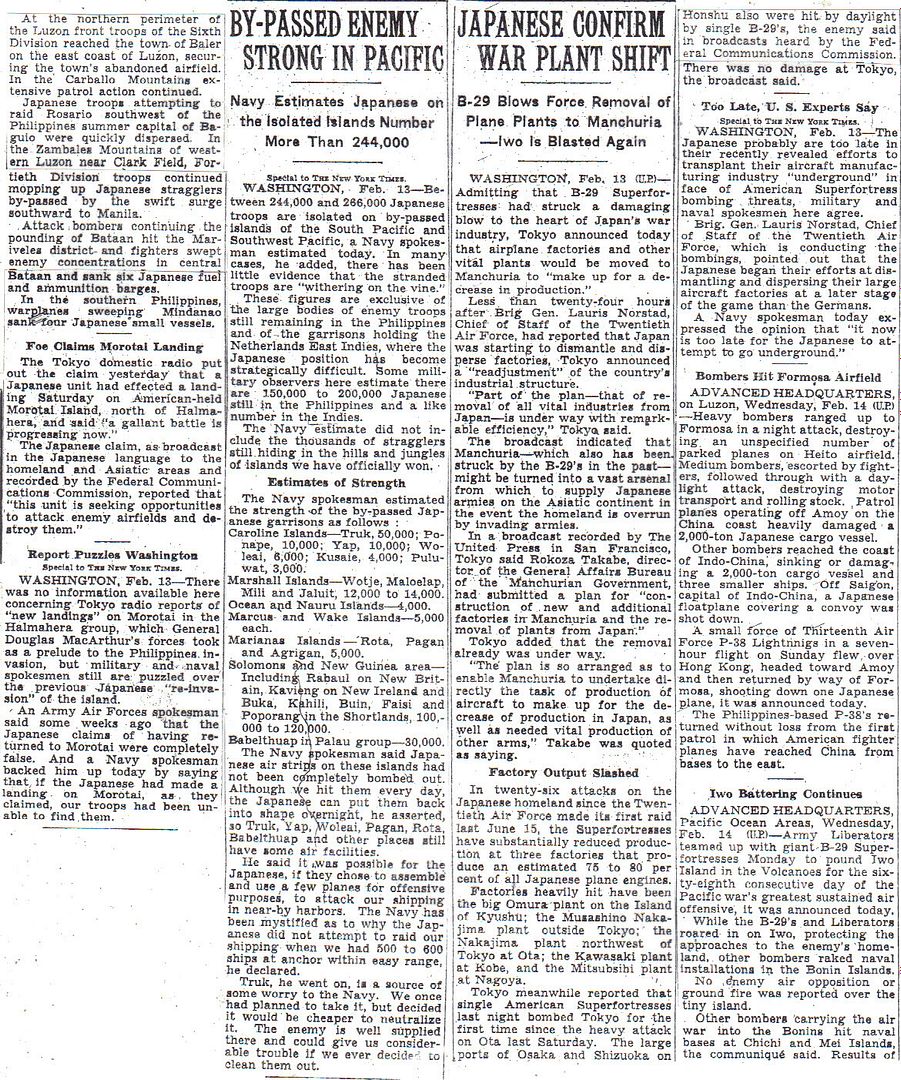
9
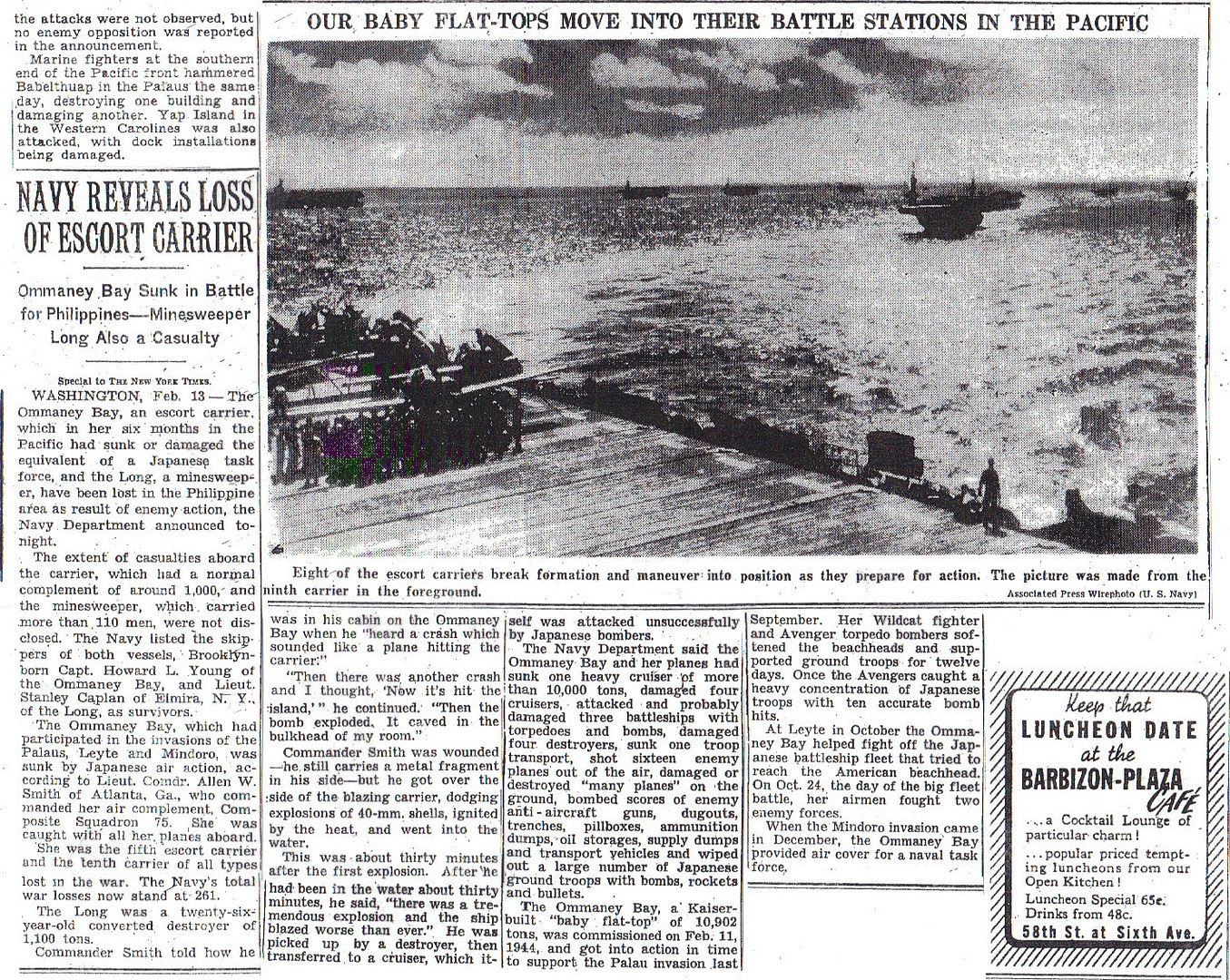
10
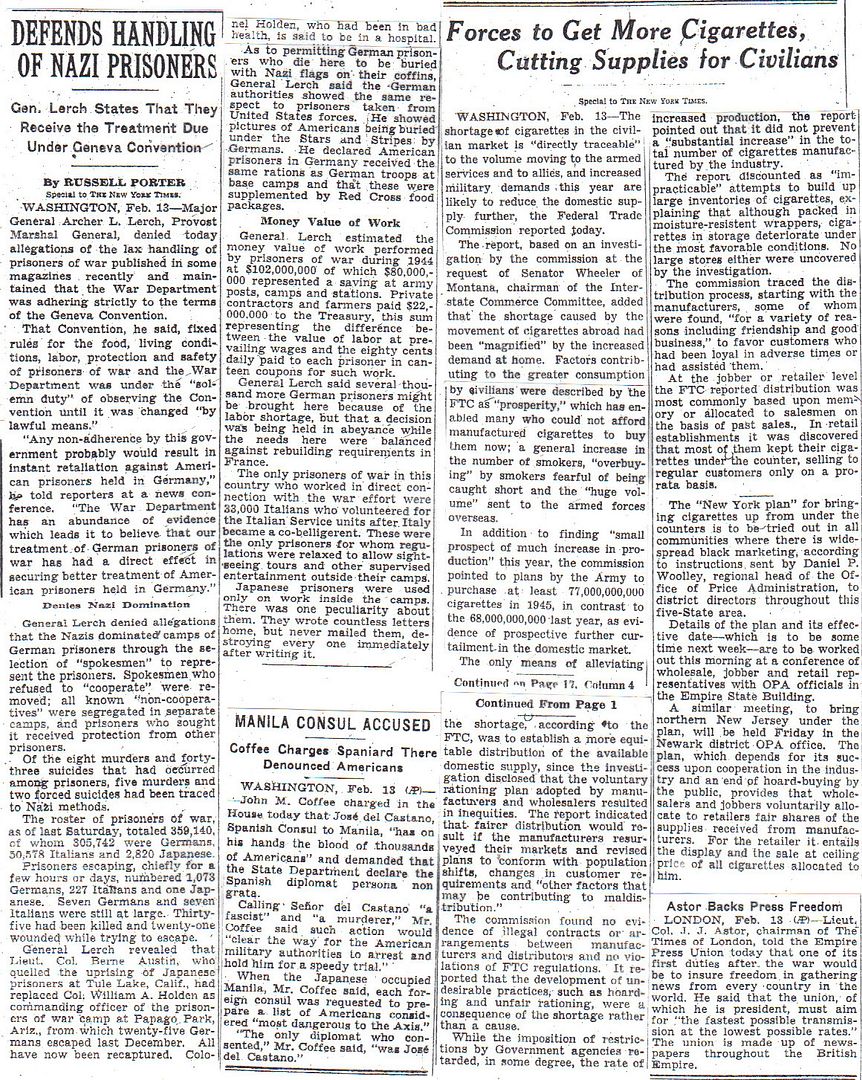
11
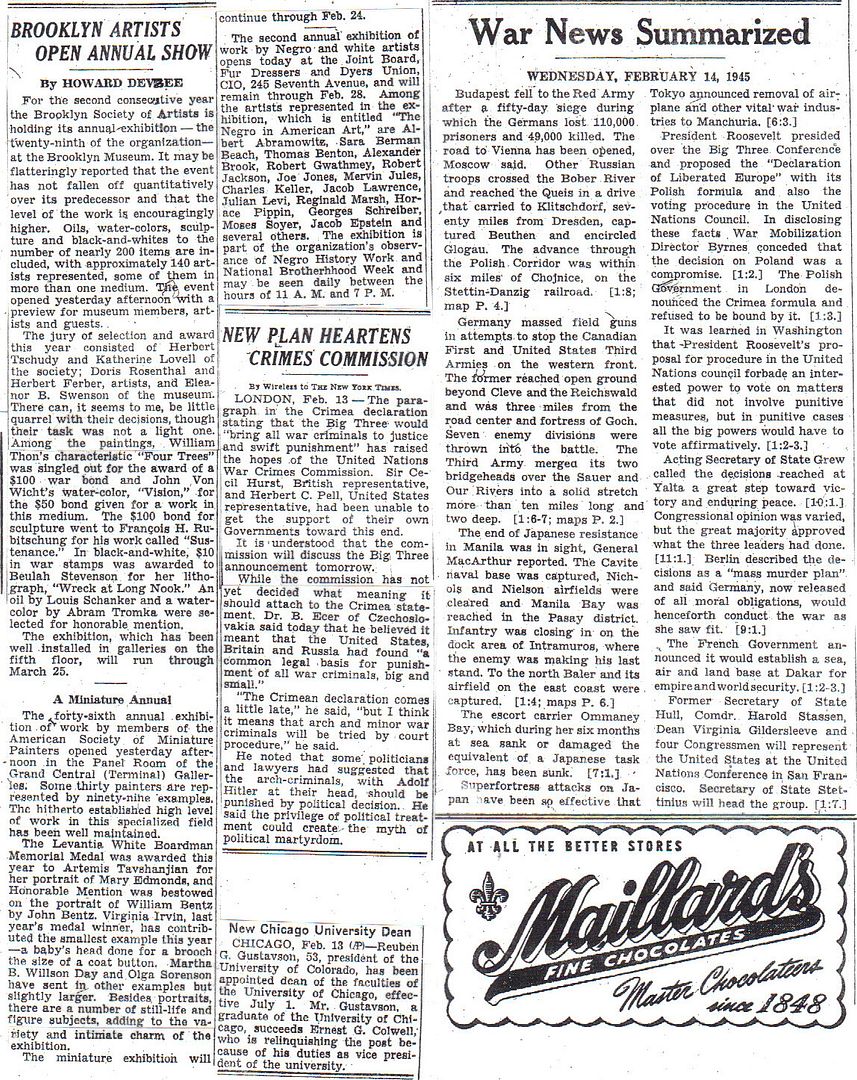
12

13

14
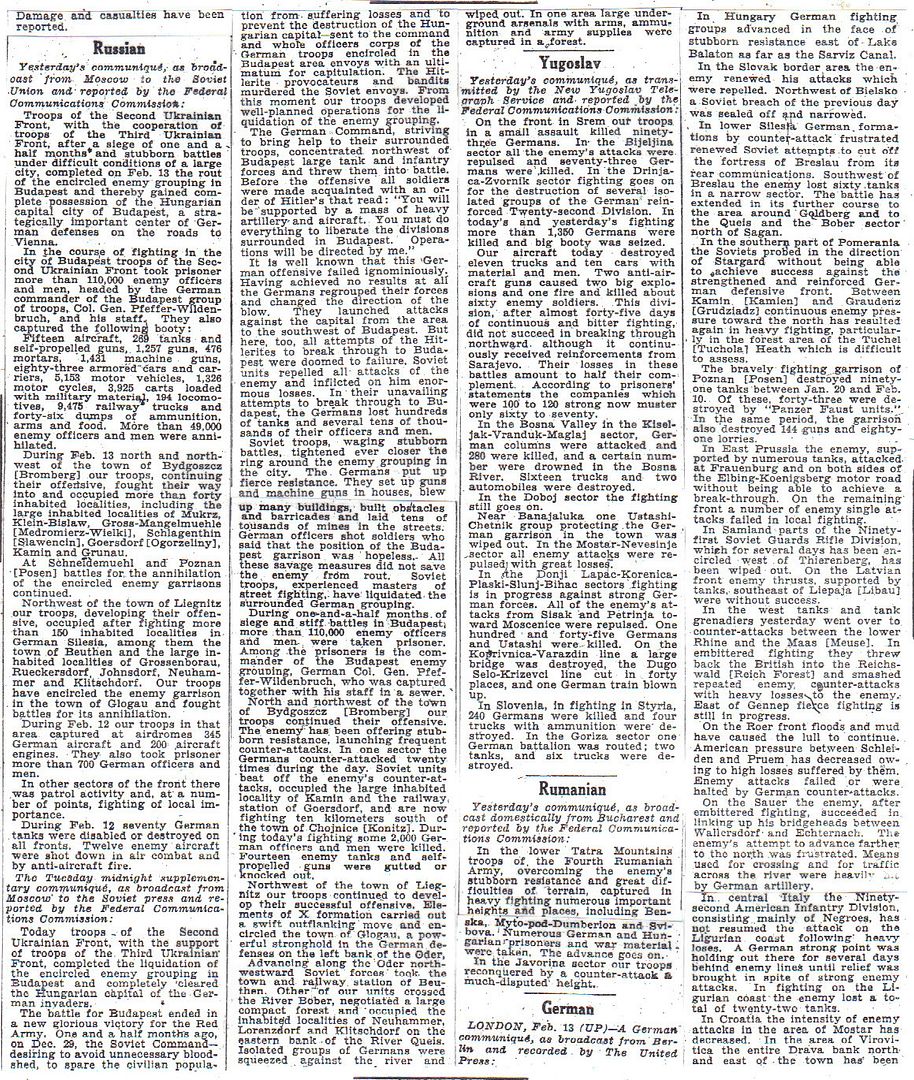
15
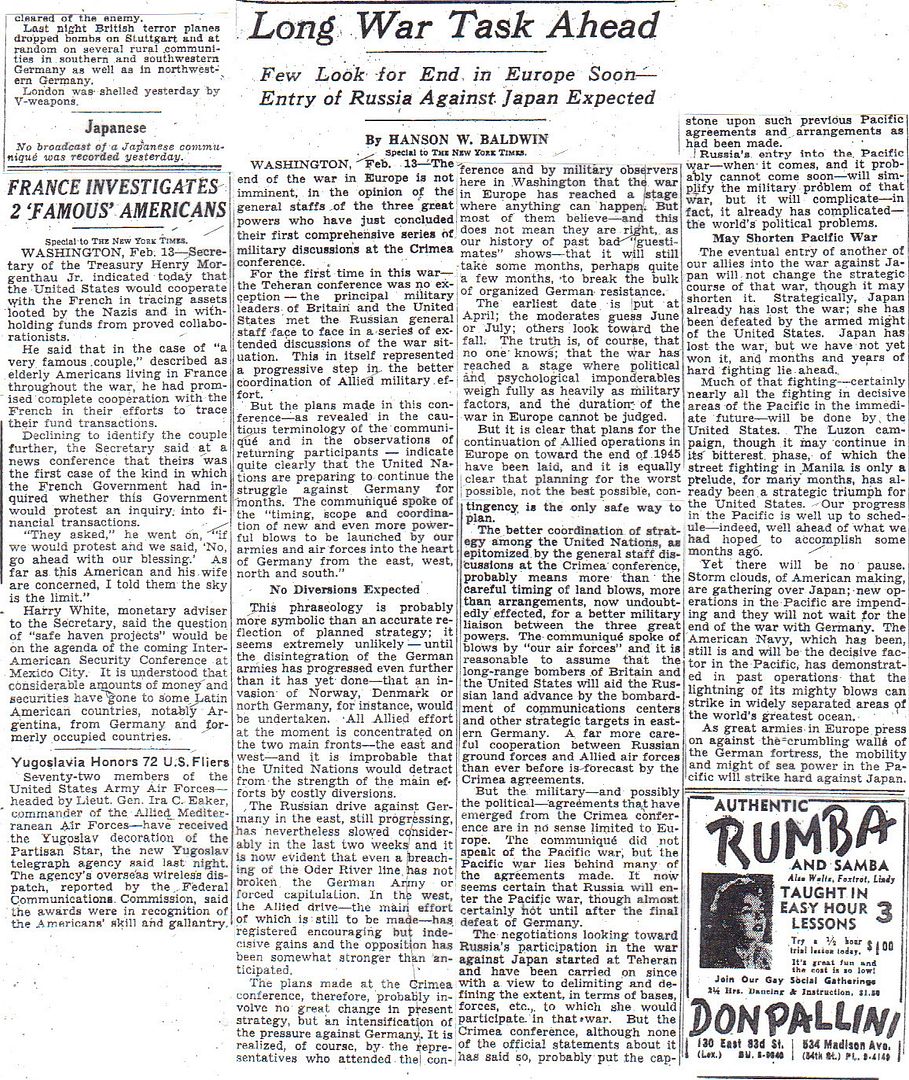
TOPICS: Extended News
KEYWORDS: history; milhist; realtime; worldwarii
Navigation: use the links below to view more comments.
first 1-20, 21-27 next last
Free Republic University, Department of History presents
World War II Plus 70 Years: Seminar and Discussion Forum First session: September 1, 2009. Last date to add: September 2, 2015.
Reading assignment:
New York Times articles and the occasional radio broadcast delivered daily to students on the 70th anniversary of original publication date. (Previously posted articles can be found by searching on keyword “realtime” Or view
Homer’s posting history .)
To add this class to or drop it from your schedule notify Admissions and Records (Attn: Homer_J_Simpson) by freepmail. Those on the Realtime +/- 70 Years ping list are automatically enrolled. Course description, prerequisites and tuition information is available at the bottom of Homer’s profile. Also visit our
general discussion thread.
To: Homer_J_Simpson
Selections from West Point Atlas for the Second World War Luzon, P.I., 1941: Final Operations on Luzon, 3 February-20 July 1945
West-Central Germany and Belgium, 1945: The Rhineland Campaign – Operations, 8 February-5 March 1945
Eastern France and the Low Countries, 1944: Summary – The Rhineland Campaign, 8 February-21 March 1945
Poland, 1945: Russian Offensive to the Oder – Operations 12 January-30 March 1945
China, 1941: Operation Ichigo, 1945 and Final Operations in the War
China-Burma, 1941: Third Burma Campaign – Slim’s Offensive, June 1944-March 1945
2
posted on
02/14/2015 4:14:52 AM PST
by
Homer_J_Simpson
("Every nation has the government that it deserves." - Joseph de Maistre (1753-1821))
To: Homer_J_Simpson
3
posted on
02/14/2015 4:15:24 AM PST
by
Homer_J_Simpson
("Every nation has the government that it deserves." - Joseph de Maistre (1753-1821))
To: Homer_J_Simpson
Continued from February 12.

Stephen E. Ambrose, Band of Brothers
4
posted on
02/14/2015 4:16:08 AM PST
by
Homer_J_Simpson
("Every nation has the government that it deserves." - Joseph de Maistre (1753-1821))
To: Homer_J_Simpson
Continued from February 11.
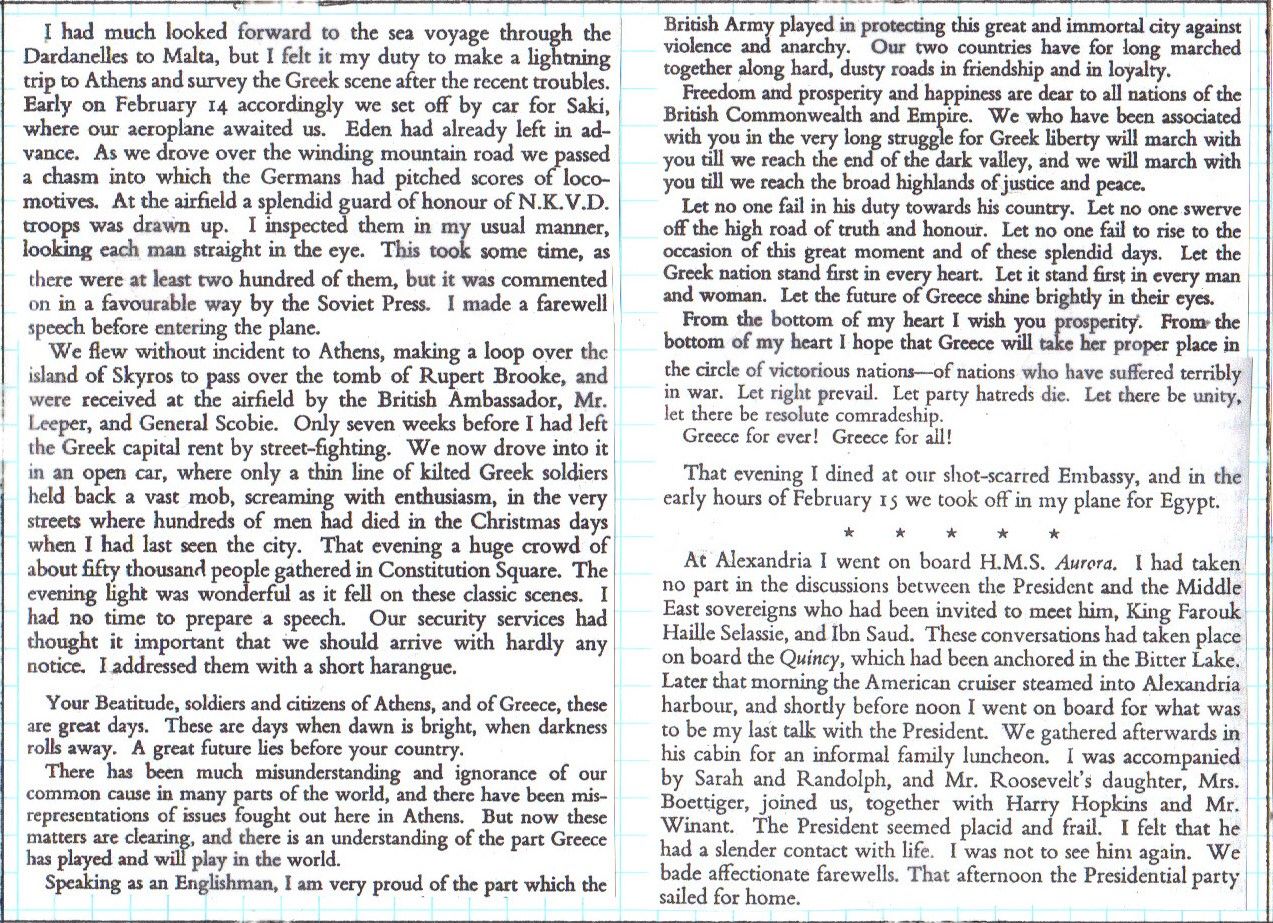
Winston S. Churchill, Triumph and Tragedy
5
posted on
02/14/2015 4:17:25 AM PST
by
Homer_J_Simpson
("Every nation has the government that it deserves." - Joseph de Maistre (1753-1821))
To: Homer_J_Simpson
It has been pointed out that the 8th Air Force began a bombing campaign on Dresden on Feb. 13. I post links to these threads on the web forum of the 381st Bombardment Group, in which my uncle was a B-17 navigator, on days that group flew a mission and the following day to show the news coverage they received from the home front. Since the 381st didn’t fly on the 12th or 13th I didn’t save the coverage for today. They did fly on the 14th and I will post today’s combat diaries from the 381st BG as well as those for the 4 squadrons in the group, the 532nd, 533rd, 534th, and 535th, on that
forum. As a special feature I will post the 381st entry here. I don’t know what cumulo-bango conditions are – HJS.
381st BG diary entry: Flying as “B” group in the Combat Wing, which led the entire First Air Division, we turned what might have been a miserable and costly failure into one of our outstanding combat performances Feb. 14.
Dresden was briefed as the target center, but the field order carried a strict injunction that nothing whatsoever would interrupt the bomber stream, heading for a target very close to the advancing Russians in southern Germany. Consequently, when the Group ahead of us led off course because of a foul cloud and contrail conditions over the central Reich, Capt. Tyson, 535th operations officer up as Group leader for our 37 bomber contingent, realized the time schedule had already been upset. He therefore had no other choice but to seek a target of opportunity.
While we peeled off in search of such an objective, after sustaining considerable damage from AA defenses, the Group ahead went plowing on through the cumulo-bango weather and flak prevailing over Munster. Capt. Pelenik, Group lead bombardier for the day, began looking for a hot target through weather that constantly varied between VACU and fubar. Although he was unaware of the full importance of what he finally selected at the time, he lined up on a vast industrial pile which later proved to be the long-sought-after SudetenländischeTreibstoffwerke, an A-plus priority synthetic oil plant two miles northwest of Brux, Czechoslovakia.
There, as strike photos later proved, lead and high squadrons did an excellent visual job, with heavy and tight bomb concentrations placed in and near the plant buildings.
The 12-plane low squadron, failing to recognize Palenik’s bomb run, made up for the oversight a few minutes later when they hammered home their explosives on the Skoda arms plant at Pilsen.
It was a rough day, with the formations encountering moderate to intense flak, first at Munster, next at Brux and finally at Pilsen. On the way out, the crews observed our excellent escort in large dogfights with the Luftwaffe although none of our formations were attacked.
Eighteen of our aircraft landed away from base, thirteen of them on the Continent, most of them for lack of fuel or because of engine failures. Two crews bailed out of their aircraft over Belgium and, of these, two were injured – 2nd Lt. E. B. Wulf and S/Sgt. C.J. Kubiak, pilot and tail gunner respectively, who were hospitalized in Belgium. Four drifted into enemy lines and presumably were made prisoners.
Missing in action are: Sgts. D. McCartney, radio; W. Tresti, ball turret; P.D. Boland, waist; and M.P. Bioavert, tail, all of the 534th.
It was rough back at the base after the remnants of the formation came in, too. The rest of the day was spent in trying to determine what it was the Fortresses hit. Grave fears were expressed that the formation was over Chemnitz at the bombs away and that the explosives had fallen on the Russians. When the target had been identified, however, there was great rejoicing. For it developed that the bombs had fallen on an objective which the Eighth had been seeking for months.
The most unusual experience of the mission belonged to 2nd Lt. Hugh D. Robinson, Jr., Wulf’s co-pilot. Having bailed out of his Fortress, Robinson was picked up just inside the Allied lines by American soldiers. Examined by a doctor, he was ordered to the hospital at Leige for X-rays. He went off in an L5, was clouded in while in the air, flew around until the fuel gave out, and then bailed for the second time. That wasn’t all. He was in a B-24, for a ride back to England, when the Liberator’s landing gear collapsed while it was taxing for take-off.
381st Bombardment Group war diaries
6
posted on
02/14/2015 4:30:25 AM PST
by
Homer_J_Simpson
("Every nation has the government that it deserves." - Joseph de Maistre (1753-1821))
To: r9etb; PzLdr; dfwgator; Paisan; From many - one.; rockinqsranch; 2banana; henkster; meandog; ...
Axis Center Falls – 2-3
The ‘Queen City of the Danube’ Taken by the Russians (photo) – 3
Yugoslav Cabinet of 24 is Foreseen (Sulzberger) – 3
Canadians Gain Near Cleve; 3d Army Links Bridgeheads (Daniel) – 4-5
3d Army Finds Foe Crowds Pillboxes (Currivan) – 5
The British Massing for Assault in Germany (page 1 photo) – 5
Live American Bait Hooks Foe 5 Times (Johnston) – 6
Permanent Peace Aided, Grew Says – 6
Naval Base Seized – 7-8
By-Passed Enemy Strong in Pacific – 8
Japanese Confirm War Plant Shift – 8-9
Navy Reveals Loss of Escort Carrier – 9
Our Baby Flat-Tops Move into Their Battle Stations in the Pacific (photo) – 9
Defends Handling of Nazi Prisoners (Porter) – 10
Forces to Get More Cigarettes, Cutting Supplies for Civilians – 10
War News Summarized – 11
The Texts of the Day’s Communiques on the Fighting in Various War Zones – 13-15
Long War Task Ahead (by Hanson W. Baldwin) – 15
7
posted on
02/14/2015 4:31:35 AM PST
by
Homer_J_Simpson
("Every nation has the government that it deserves." - Joseph de Maistre (1753-1821))
To: Homer_J_Simpson
http://www.etherit.co.uk/month/1/14.htm
February 14th, 1945 (WEDNESDAY)
UNITED KINGDOM: Rescue tug HMS Expert launched.
ENGLISH CHANNEL: Destroyer HMCS Assiniboine damaged in a collision with the merchantman SS Empire Bond. She was under repair in Sheerness until early March.
BELGIUM: HMC MTB 459, 461, 462, 465, 466 destroyed by fire at Ostend.
GERMANY: Dresden is attacked by the RAF (773 bombers), during the night of the 13th-14th. The US 8th AF follows up on the 14th and again on the 15th with raids exceeding 600 bombers each day.
Eighth Air Force’s 1st Air Division dispatched 461 B-17s to hit the marshalling yard at Dresden; 311 hit the primary target dropping 771 tons of bombs; 124 others hit targets of opportunity.
Dresden, a city so rarely attacked that its citizens took no notice when air-raid warnings sounded, was devastated last night in the fiercest firestorm ever created by RAF Bomber Command. Over 18,000 people are confirmed dead in this city whose population of 700,000 had been swollen by as many as 500,000 refugees from the east. Conditions were perfect for Wing-Commander Maurice Smith and his 244 Lancasters. Most of Dresden’s flak guns had been sent to the front, and the few available nightfighters did not arrive until too late.
The marker flares went down dead on target, then Smith ordered the destruction to start. High explosive bombs opened up the buildings; then the incendiaries went down and soon the city was ablaze. “That’s good bombing,” said the controller. The bombers wheeled away and then came another wave of 529 Lancasters. In all, 1,478 tons of HE and 1,182 tons of incendiaries were dropped. Then the firestorm started. People were sucked into the inferno like leaves into an autumn bonfire. Many took shelter in cellars, only to die of suffocation.
Why has such devastation been visited on Dresden, a city of great architectural but little military value? The attack stems from plans for Operation Thunderclap designed to precipitate Germany’s surrender by a series of heavy raids on the railway network. Dresden is a transit centre for part of the eastern front, but last night’s attack was also explicitly aimed at hastening the end of the war by destroying German morale. There was opposition to this plan, especially from the Americans, who called it “terroristic”; but it was ultimately endorsed on the grounds that it might help the Russians militarily, by attacking German communications, and politically, by being seen to support the Red Army. Thus, today the USAAF also played its part in the terror.
In response to a Red Cross inquiry concerning British and American prisoners of war who are too ill to march with others being evacuated from the camps at Sagan and Lamsdorf, Hitler personally decides, contrary to both the Geneva Convention and previous official German policy, that they are not to be left behind. They are to be brought back with the first available train returning after delivering supplies to the front. (175, p.73)(Peter Kilduff)
U-3039 launched.
U-2364, U-3030 commissioned.
ARCTIC OCEAN: Between 1247 and 1304, U-968 fired torpedoes at the convoy BK-3 off Kola Inlet and reported one Liberty probably damaged, one Liberty probably sunk, a tanker identified as Norness sunk and a Liberty damaged. However, the only ships hit at this time were Norfjell and the Horace Gray. This attack was probably misinterpreted by U-992, which herself attacked the convoy and claimed one tanker sunk. The Horace Gray in station #13 was hit by one torpedo on the port side at the bulkhead between the #4 and #5 holds, only minutes after the tanker ahead of her had been hit. The explosion blew the hatch covers off and opened a hole 20 feet by 60 feet in the port side and another 20 feet by 20 feet on the starboard side. The ship settled rapidly by the stern until water reached the after deck. 20 minutes after the hit the eight officers, 33 crewmen and 28 armed guards (the ship was armed with one 5in, one 3in and eight 20mm guns) abandoned ship in the four lifeboats and were picked up by two Soviet escort vessels. One hour after being hit, the master and some crewmen returned to the ship and after raising steam, a small Soviet tug towed her to Kola Inlet. While under tow a crack appeared on the starboard side and the vessel began to sink. Eight hours after being hit, the ship was beached at Tyuva Bay in 69°11.7N/33°36.5E and two days later declared a total loss after all holds were completely flooded. The Horace Gray had arrived Molotovsk on 19 January in convoy JW-64 from New York via Swansea, Wales. In 1959, the bow of the wreck of Horace Gray was fitted to Tbilisi, which had been badly damaged by U-956 (Mohs) on 30 Dec 1944. The Norfjell was hit by one torpedo in the engine room, killing two men on watch below and opening a hole of about 14 to 5 meters. The tanker remained afloat was taken in tow by the escort and beached near Tree Roochia in the Kola Inlet. The damage was temporarily repaired at Murmansk and she left in tow on 20 Oct 1945 to Stavanger for permanent repairs, arriving on 15 November. The Norfjell with 41 crew members and eight gunners had arrived North Russia in convoy JW-63 and was on the outbound voyage in convoy BK-3 in order to join convoy RA-64.
COMMONWEALTH OF THE PHILIPPINES: USS YMS-48 sunk by USS Fletcher north of Corregidor at 14.24N, 120.33E, after being damaged by Japanese shore batteries.
AUSTRALIA: Frigate HMAS Lachlan commissioned.
CANADA: Destroyer HMCS Restigouche returned to Halifax for local duties.
U.S.A.: New York: William C. Colepaugh and Erich Gimpel, German spies who landed by U-boat on 29 November, are sentenced to death.
Peru, Paraguay, Chile and Ecuador join the United Nations.
Oiler USS Mispillion laid down.
Submarine USS Conger commissioned.
Frigate USS Bayonne commissioned.
URUGUAY: Montevideo: The government declares war against Germany. (Gene Hanson)
ATLANTIC OCEAN: U-989 Kl. VIIC is sunk 14 Feb, 1945 in the Northern Sea at the Faeroe Islands, in position 61.36N, 01.35W by depth charges from the British destroyers HMS Bayntun and Braithwaite and the British frigates HMS Loch Eck and Loch Dunvegan. 47 dead (all hands lost).
[When the boat was sunk 2 men managed to escape from the boat. They both died reaching the surface, presumably from escaping the boat too deep. One of the men was the commander, von Roithberg. He died on his 27th birthday.] (Alex Gordon)
8
posted on
02/14/2015 4:32:40 AM PST
by
Homer_J_Simpson
("Every nation has the government that it deserves." - Joseph de Maistre (1753-1821))
To: Homer_J_Simpson
While he must've possessed it in spades, Cpl McClung's ability to "smell Germans" was apparently not uncommon, either figuratively or literally. Uncle C commented on being acutely aware of it when transporting POWs across France, and I have also heard vets remark about friend and foe all smelling like goats, but "different" goats nonetheless.
When the souvenirs would get brought out of their hiding places and shown to the little boy who showed an interest in such things, there was generally a distinctive smell lingering about the German items. I still remember one particularly aromatic 98K ammunition pouch which contained odds and ends that - regrettably - disappeared over the decades. The few of these items I have managed to keep around seem to have lost most of their pungency, although it may also be that my sense of smell has deteriorated over 50 years.
Mr. niteowl77
9
posted on
02/14/2015 5:42:20 AM PST
by
niteowl77
(The five stages of Progressive persuasion: lecture, nudge, shove, arrest, liquidate.)
To: Homer_J_Simpson
Page 4 NYT map - Looks like we’ve got a sort of concave curve on the western front. Last I read, Ike wanted to straighten the western front line. Maybe somebody’s lagging in the middle there. I wondered why Ike wanted a straight front and thought maybe to make it harder for the enemy because there are no flanks to attack.
10
posted on
02/14/2015 6:44:43 AM PST
by
PapaNew
(The grace of God & freedom always win the debate in the forum of ideas over unjust law & government)
To: Homer_J_Simpson; Clive; exg; Alberta's Child; albertabound; AntiKev; backhoe; Byron_the_Aussie; ...
To all- please ping me to Canadian topics.

Canada Ping!
11
posted on
02/14/2015 9:26:00 AM PST
by
Squawk 8888
(Will steal your comments & post them on Twitter)
To: Homer_J_Simpson
Nimitz’s Cincpoa entries 140110, 140112 and 140759 are very interesting. Is he trying to clue us in that something more that the routine bombardment of Iwo Jima is in the works?
12
posted on
02/14/2015 9:27:17 AM PST
by
fso301
To: Homer_J_Simpson; Tax-chick; henkster; colorado tanker; EternalVigilance
“...I felt it my duty to make a lightning trip to Athens...”
“At the airfield a splendid guard of honour of N.K.V.D. troops was drawn up. I inspected them in my usual manner, looking each man straight in the eye. This took some time, as there were at least two hundred of them...”
I love Churchill! He is making a “lightning trip” but takes the time to look each of 200 Soviet men in the eye because he was once in their shoes an knew the effort it took to get turned out for such an occasion for a “big wig” (unlike life-long political operative Stalin or Barry).
13
posted on
02/14/2015 9:30:15 AM PST
by
Seizethecarp
(Defend aircraft from "runway kill zone" mini-drone helicopter swarm attacks: www.runwaykillzone.com)
To: PapaNew
I wondered why Ike wanted a straight front and thought maybe to make it harder for the enemy because there are no flanks to attack.That and because it would be the fair thing to do. He didn't want any of his generals to suffer loss of self esteem and not feel good about themselves.
14
posted on
02/14/2015 9:30:37 AM PST
by
fso301
To: Homer_J_Simpson
BELGIUM: HMC MTB 459, 461, 462, 465, 466 destroyed by fire at Ostend.”
This is a pretty obtuse reference. What are MTBs? Why were there 5 of them in Ostend?
I did do a search on it and learned that an MTB was a Vosper 70 ft Motor Torpedo Boat (although the wiki article skips the 400 range as this type of MBT).
“Although various boat lengths were produced by Vosper for the Royal Navy, the “70 ft” boat was produced from 1940. The design was produced with modifications as MTBs 31-40, 57-66, 73-98, 222-245, 347-362, 380-395 and 523-537.
Using three Packard marine engines, they were capable of around 37 kn (43 mph; 69 km/h). Early models carried two 21-inch (533 mm) torpedo tubes, two 0.50 in (13 mm) machine guns and two 0.303 in (7.7 mm) machine guns. They could also carry four depth charges.
Also from wiki: After the end of World War II a number of Royal Navy vessels were stripped and sold for use as houseboats.
A torpedo boat would be my ultimate dream boat.
To: niteowl77
contained odds and ends that - regrettably - disappeared over the decadesMy dad brought home a rock from Hitler's fireplace in Bertchesgaden which - regrettably - has suffered a similar fate.
16
posted on
02/14/2015 10:01:46 AM PST
by
Hebrews 11:6
(Do you REALLY believe that (1) God IS, and (2) God IS GOOD?)
To: Homer_J_Simpson
Churchill also noted that they flew to Athens, “making a loop over the island of Skyros to pass over the “tomb of Rupert Brooke,”.
Huh, When Winston wrote this in 1953 in Triumph and Tragedy, folks might have had a clue who Brooke was and why he was buried in Skyros Greece.
We of cousre have to go to wiki for answers. Rupert Chawner Brooke (3 August 1887 – 23 April 1915) was an English poet known for his idealistic war sonnets written during the First World War, especially “The Soldier”.
Brooke’s accomplished poetry gained many enthusiasts and followers and he was taken up by Edward Marsh who brought him to the attention of Winston Churchill, then First Lord of the Admiralty. He was commissioned into the Royal Naval Volunteer Reserve as a temporary Sub-Lieutenant shortly after his 27th birthday and took part in the Royal Naval Division’s Antwerp expedition in October 1914. He sailed with the British Mediterranean Expeditionary Force on 28 February 1915 but developed sepsis from an infected mosquito bite. He died at 4:46 pm on 23 April 1915 in a French hospital ship moored in a bay off the island of Skyros in the Aegean on his way to the landing at Gallipoli. As the expeditionary force had orders to depart immediately, he was buried at 11 pm in an olive grove on Skyros, Greece.
To: Homer_J_Simpson
Ernie Pyle, in his last column to involve in any way life back home, gives us a glimpse of Hollywood before we all found out all too much about it.
____________________________
Pyle writes about the "The Story of GI Joe," a movie based on Pyle's columns.
In the Movies
SAN FRANCISCO – And now about the movie which is being partly based on these columns from the war fronts over the last two years.
Well, the movie is finished at last. I mean the shooting is finished. But there are a lot of things we laymen don’t know about the movies, and one of them is that a film isn’t ready to show for about three months after they’ve finished shooting. So I don’t expect you’ll be seeing it till April or May.
They are still calling it "The Story of G.I. Joe." I never did like the title, but nobody could think of a better one, and I was too lazy to try.
It is a movie about the infantry. There isn’t much of a story to it, and there’s no conventional love interest running through it. The War Department co-operated and furnished two companies of soldiers, who were moved to Hollywood, plus lots of equipment such as trucks, tanks, guns and what not.
The soldiers all grew beards, and although they got awfully itchy, the boys said the girls in Hollywood sure do go for a soft, flossy beard. The only tragedy was when one soldier’s beard caught fire one day and he got pretty badly burned. I don’t know whether he got a Purple Heart.
***
The six main soldier characters in the picture were played by professional actors. But the run-of-the-mill soldiers were played by real soldiers. As was expected, a couple of the real soldiers turned out to be "finds" as actors. By the time you see the picture, practically all the soldiers in it will be fighting overseas.
I spent a week in Hollywood nosing into the picture in October, another week in December. I still don’t know whether it will be a good picture or not, but I think it will.
If it isn’t a good picture, it will not be for lack of good intentions. They have worked a year and a half on it, and spent more than a million dollars. They’ve slaved to avoid "Hollywooding" it. They’ve sought, and listened, to advice from men who know what war is.
They’ve had at least one veteran war correspondent there all the time. The army has kept never less than three overseas veterans of combat out there constantly. As I left Hollywood, one of these veterans said, "I think it’s going to be a good picture. At least I think it will be the most authentic war picture ever made."
***
My own part in it is very minor. My part is played by Capt. Burgess Meredith. The makeup men shaved his head and wrinkled his face and made him up so well that he’s even uglier than I am, poor fellow.
The picture was directed by "Wild Bill" Wellman, one of Hollywood’s top men. The picture was produced by Lester Cowan, an independent, through United Artists. If it’s a lousy picture, poor Lester will have to face the wrath of about two million irate soldiers. If it isn’t a lousy picture, then he can float on air for years.
An almost anonymous person whose hand bore strongly on the picture is an old Indiana school friend of mine named Paige Cavanaugh. Being one of my closest friends, he quit whatever he was doing last spring and went to work for Lester Cowan, largely to insure, as Lester puts it, that "Cowan didn’t louse Pyle up."
But as time went on Cavanaugh’s innate good sense began to make an impression around Hollywood, and in the end they have leaned heavily on his judgment. Cavanaugh, being a farmer at heart, still sneers at Hollywood, but he’s got a gleam in his eye that looks permanent to me.
***
When the picture is finally ready for release, they hope to fly a print across the Pacific and let me have a little world premiere of my own before a few hundred fighting infantrymen somewhere in the Far East.
But there won’t be any single premiere in America. It will open simultaneously in 100 cities. My little old hometown of Dana, Ind., and my new hometown of Albuquerque will, of course, be among them.
The theater manager in Dana has volunteered to let my father and Aunt Mary in free on opening night. They think that’s sure mighty nice, and they’ll probably take him up on it.
Source: Rocky Mountain News, February 14, 1945: from a scrapbook given to Indiana University by Mrs. Henry Schoon. Pictures courtesy of The Lilly Library, Indiana University, Bloomington, Indiana
back to Wartime Columns
To: Homer_J_Simpson
“BUDAPEST IS TAKEN AT COST OF 159,000 TO FOE;”
Absolutely no doubt that the Battle of Budapest was a bloodbath, but the sources vary as to how many the Germans lost there. They run from 99,000 to 140,000 total killed, wounded and captured.
The Russians has 320,000 casualties, with about 80,000 killed.
19
posted on
02/14/2015 12:00:52 PM PST
by
tcrlaf
(They told me it could never happen in America. And then it did....)
To: untenured
No one wrote so plainly and clearly as Pyle.
Which is one of the reasons why he was so beloved by Americans.
Thanks for sharing that.
Navigation: use the links below to view more comments.
first 1-20, 21-27 next last
Disclaimer:
Opinions posted on Free Republic are those of the individual
posters and do not necessarily represent the opinion of Free Republic or its
management. All materials posted herein are protected by copyright law and the
exemption for fair use of copyrighted works.
FreeRepublic.com is powered by software copyright 2000-2008 John Robinson

